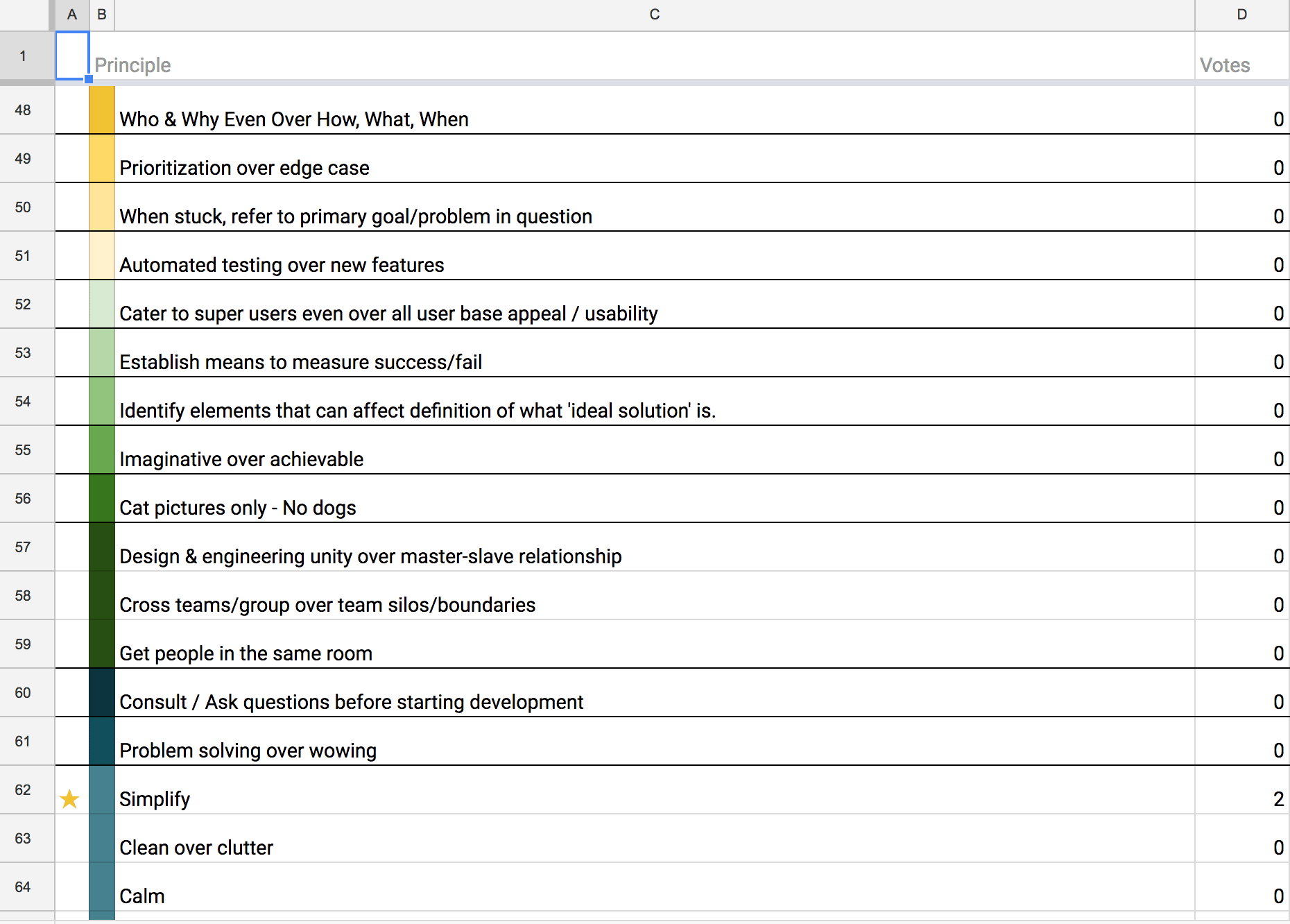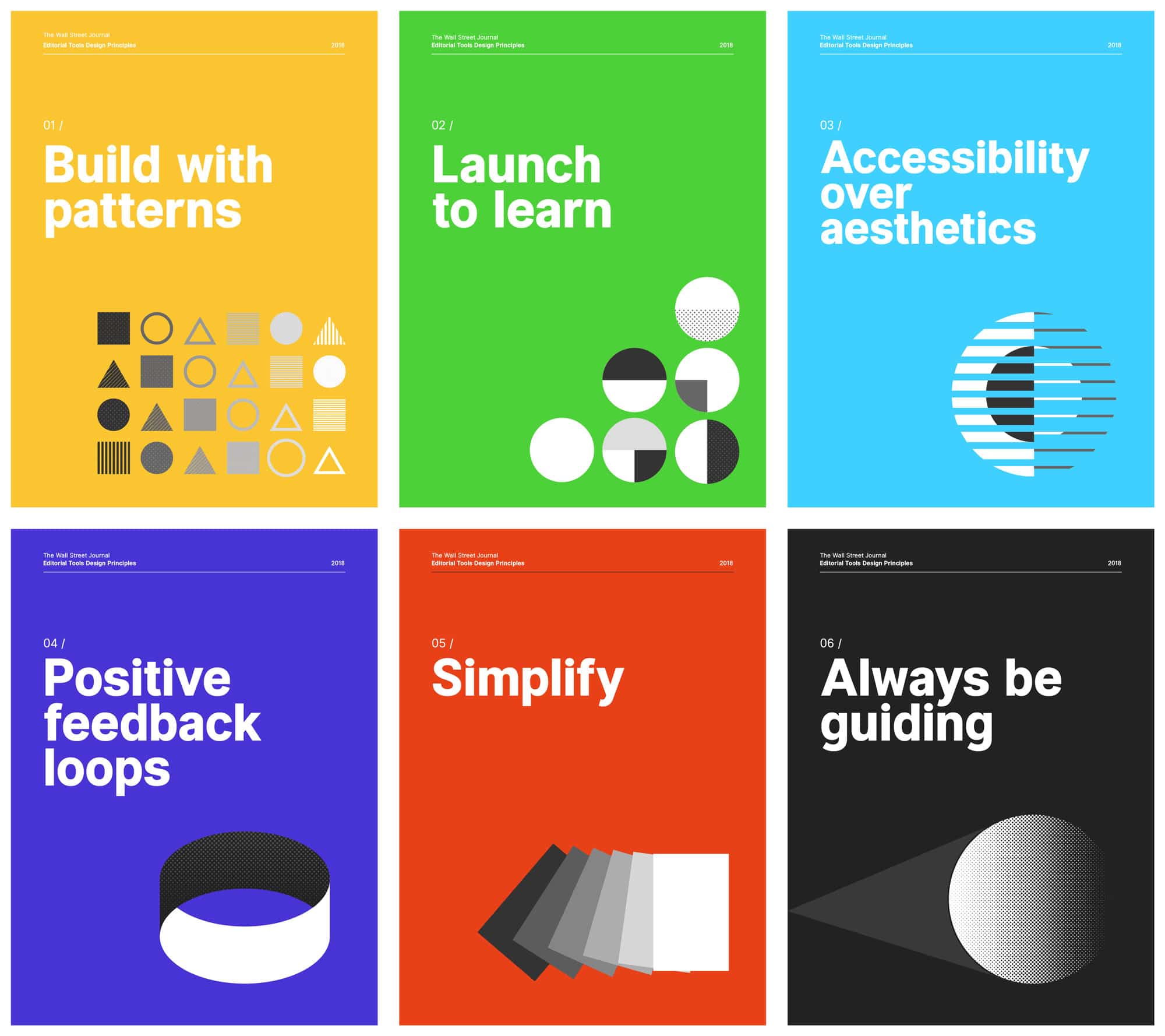Design principles are a valuable tool for any team that works together towards a shared outcome. Written well, design principles can create alignment, speed up decision-making, and increase the quality of the team’s output.
Lately, I’ve worked with two of my teams to write design principles. Turns out writing down design principles is easy1; agreeing on principles as a team is much harder. In earlier writing, I missed an important quality of good design principles:
Good design principles are written as a team.
I learned this lesson the hard way. If you bring fully-formed principles to your team to adopt, you’re missing an important opportunity to align with your teammates.
Based on this experience, I’ve designed a workshop to enable teams to collaboratively write design principles.
Planning
1. Decide who should attend
Here’s a great parable that was told to me by Marina, program manager and scrum master extraordinaire:
Pig and a Chicken are walking down the road. Chicken says: “Hey Pig, I was thinking we should open a restaurant!” Pig replies: “Hm, maybe, what would we call it?” Chicken responds: “How about ‘bacon-n-eggs’?” Pig thinks for a moment and says: "No thanks. I’d be committed, but you’d only be involved.”2
We use the chicken and pig parable to describe two kinds of team members: ones who contribute as consultants and experts, and ones who are accountable for outcomes. Chickens are trusted collaborators, but pigs are the ones with skin in the game.
Writing design principles is a job for the pigs. Include those who are directly affected by the outcomes of your work, and alignment and shared values will be much easier to attain.
A note about remote teams
You don’t need your team to be in the same room to run this workshop. If some (or all!) of your team is remote, use real-time feedback tools like Slack, Google Docs, and Zoom/Hangouts/Bluejeans/etc. in the place of writing, sharing, and voting on principles.
2. Gather your materials
You’ll need your standard design thinking toolkit for this workshop:
- Tons of post-its: As a team of 8, we used more than 100 post-its. Seriously, bring a lot.
- Dot stickers: Multiply the number of attendees by the number of principles you want to write, and bring that many + 10. For instance: a group of 8 writing 5 principles would need ( 8 x 5 ) + 10 = 50 dots.
- Large-tipped markers:3 Bring one for each attendee.
3. Set roles
There are two assigned roles for this workshop:
- The facilitator: A good facilitator should do three things:
- Set expectations: The facilitator should share the ground rules and desired outcome of the workshop with the team well before it starts.
- Watch the clock: Just like in the NFL, clock management wins championships. It’s a big challenge, but well-timed workshops are a thing of beauty.
- Keep everyone safe: It takes a lot of candor and vulnerability to share a design principle with the group. The facilitator should pay close attention to group dynamics, and work hard to ensure everyone feels comfortable contributing.
- The scribe: The scribe’s responsibility is to record the decisions that the team makes. This may seem like a trivial task, but good notes help maintain team alignment after the workshop is over.
4. Get prepared
Before the workshop, the facilitator should prepare an overview of the task at hand. Be prepared to answer questions like, “What is a design principle,” “Who uses design principles,” and “What makes a good design principle.”
I have my own set of guidelines, but I encourage you to find the right guidelines for your team: some do better with little guidance, some thrive with constraints. Here’s the template of the presentation I’ve given during the “align” phase of the workshop:

Feel free to copy it and make it your own!
If you have a co-located team, make sure to book a quiet conference room with lots of space. Spend 10 minutes setting up the room: get water and coffee, and if you’re feeling ambitious, bring some snacks.
The Workshop
| Activity | Time (in minutes) |
|---|---|
| Check-in | 5 |
| Align | 10 |
| Diverge & Write | 15 |
| Converge & Theme | 15 |
| Vote | 10 |
| Check Out | 5 |
When the team arrives, quickly review the agenda and nicely ask insist that everyone put their phones and/or laptops out of sight.4 Then, kick of the check-in round.
Check-in round: 5 minutes
A check-in round is a simple turn-based exercise in getting everyone on the same wavelength. The facilitator starts by giving the group a personal status update. After that, the person to the left of the facilitator gives their personal status, and so on, until everyone’s checked in.
It’s tempting to just say “I’m good” and move on, but the check-in round is an opportunity to express a little bit of vulnerability in order to create psychological safety. Daniel Coyle, in The Culture Code, sums it up nicely:
Vulnerability doesn’t come after trust — it precedes it. Leaping into the unknown, when done alongside others, causes the solid ground of trust to materialize beneath our feet.
A good check-in round establishes a baseline of trust, and enables the kind of candor required to write great design principles.
Align: 10 minutes
Now’s the time for the facilitator to give their overview of the desired outcome. The facilitator moves quickly through any material they have, leaving time for the participants to ask any questions they have.
The goal of the “alignment” phase is to make sure everybody is working towards the same outcome, and has a feeling of common understanding.
Diverge & Write: 15 minutes
The facilitator sets a timer for 15 minutes, and the participants get to writing. Participants should write one principle per sticky note, and keep writing for the whole 15 minutes.
Some tips I find useful:
- If you get stuck, just write down the first thing that comes to mind and crumple it up. Post-it notes are cheap.
- Put on some thinking music. My favorite music to get a room in sync is Steve Reich’s Music for 18 Musicians. Classical music (Ravel is my favorite) works too. Keep the volume down, and respect people’s preferences if they’d rather work silently.
- If you’re facilitating, keep an eye out for anyone who isn’t writing. Quietly ask them if they need any help, and give them guidance. It’s important that everyone contribute, even if they’re not 100% confident in their own ideas.
At the end of 15 minutes, the facilitator calls ‘markers down.’
Converge & Theme: 15 minutes

Next, the participants take turns reading their principles aloud and sticking them on the walls.5 The writer chooses where to stick their principles, but the facilitator should guide them to stick similar principles in tight clusters.
For instance, in a workshop I recently facilitated, these principles were in a cluster:
- Keep language friendly & empathetic
- Friendly over corporate
- Hugs over orders
- [drawing of a butterfly]
- [drawing of a smiling face]
- Clean, but cheerful
If you have lots of participants, you can save time by reading and theming only unique principles; a writer can choose to skip reading a principle that’s already been shared.
At the end of the theming phase, the group should have heard all the principles. The facilitator should take a minute and put a blank post-it next to each cluster to collect votes.
Vote: 10 minutes
The facilitator then gives each participant voting dots. Everyone spends 10 minutes putting dots on the sticky note next to the clusters they feel are the best principles for the team.
Voters are allowed to use multiple votes on any given cluster; I’ve seen people use three or four votes on a cluster they feel strongly about.
At the end of 10 minutes, the facilitator should quickly read out the results; at this point, everyone should be able to see where the votes are, so there’s no need to do a detailed tally.
Check-out round: 5 minutes
To finish the workshop, each participant give a quick personal status, echoing the check-in round. If time is short, it’s tempting to skip the check-out round, but checking out is just as important as checking in. Instead of the team filtering out one by one, or the facilitator banging a proverbial gavel, the team gets to close the meeting out as a group.
The Results
After an hour of intense collaboration, the team will have written a ton of design principles, grouped them into themes, and rated them. What the team does next is up to them.
In the case of the Wall Street Journal Editorial Tools team, I (the facilitator) translated the principles into a spreadsheet, themed them by color, and highlighted the principles with the most votes.

Then, I edited the highest voted principles to better capture their theme, then published them in a series of posters.

This is just one way of publishing design principles; you could keep them in a team wiki, print them on notebooks, or make laptop stickers. The important thing is to make them as visible as possible; the more the team (and collaborators from other teams) see the principles, the more deeply embedded they’ll become.
Conclusion
Since writing design principles as a team, we’ve been able to more quickly make difficult decisions, as well as stay aligned across a number of simultaneous projects. There’s been some re-interpretation of our original thinking along the way, but since the workshop was only an hour, it doesn’t feel like sacrilege to tweak as we go.
The team-authored principles are a huge upgrade over those I wrote alone: not only are they adopted on a much deeper level, but I’ve also been challenged to consider how our product looks from my teammate’s perspective.
Even if you don’t end up using the principles day-to-day, the process of articulating values as a team is a huge investment in the realtionships your teammates have.
Join the mailing list
I'll send new posts to your inbox, along with links to related content and a song recommendation or two.
While the parable of Chicken and Pig is no longer part of official scrum lore, I still find it a useful metaphor. If you’re a vegan, just substitute a pea plant for the chicken and a carrot for the pig. ↩︎
The larger the marker, the more articulate you have to be. Chisel-tip sharpies are my secret weapon in fighting long-windedness. ↩︎
There will be some exceptions here (scribe, remote folks, etc). However, the fewer screens in the room, the better. ↩︎
Remote folks can read their principles out, and guide someone in the room to re-write and stick their principles up. ↩︎